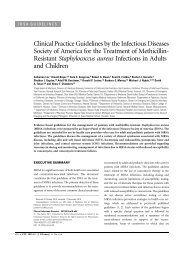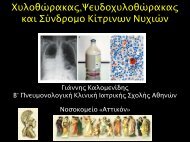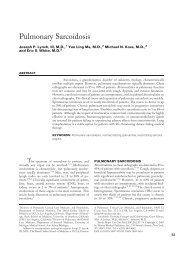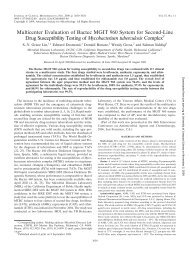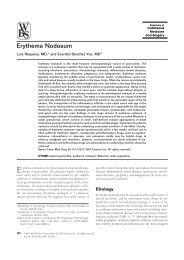OP- COP- BOOP
OP- COP- BOOP
OP- COP- BOOP
Create successful ePaper yourself
Turn your PDF publications into a flip-book with our unique Google optimized e-Paper software.
<strong>OP</strong>- C<strong>OP</strong>- BO<strong>OP</strong><br />
Σ Α Παπίρης
Organizing pneumonia is<br />
a non-specific<br />
response to<br />
various<br />
forms of lung injury and is<br />
the pathological hallmark<br />
of the distinct<br />
clinical entity termed<br />
cryptogenic organizing<br />
pneumonia
Organizing pneumonia is one of the<br />
main reparative reactions<br />
to acute injury by the lung and<br />
reflects the incomplete<br />
resolution of inflammation within<br />
the alveoli, and to a lesser extent the<br />
distal bronchioles
<strong>OP</strong>- C<strong>OP</strong>- BO<strong>OP</strong><br />
• Organising pneumonia of determined<br />
cause<br />
• Organising pneumonia of undetermined<br />
cause but occurring in a specific and<br />
relevant context<br />
• Cryptogenic (idiopathic) organising<br />
pneumonia
Causes of organizing pneumonia and associations with other conditions
The “typical”” C<strong>OP</strong> syndrome<br />
Flu-likelike illness accompanied with fever,<br />
non-productive<br />
cough, malaise, anorexia and weight<br />
loss.<br />
Dyspnoea is common but usually mild and evident<br />
only on exertion.<br />
Less common symptoms are bronchorrhoea, haemoptysis<br />
(but<br />
severe haemoptysis is exceedingly rare),<br />
chest pain,<br />
arthralgia and night sweats.
<strong>OP</strong> – C<strong>OP</strong> - BO<strong>OP</strong><br />
Lange, a German pathologist, first described the pathological findings of<br />
BO<strong>OP</strong> in two autopsies in 1901<br />
• Davison AG, Heard BE, McAllister WAC, and Turner-<br />
Warwick ME. Cryptogenic organizing pneumonitis.<br />
Q J Med 1983; 52: 382-394<br />
394<br />
• Epler GR, Colby TV, McLoud TC, and Gaensler EA.<br />
Bronchiolitis obliterans organizing pneumonia.<br />
N Engl J Med 1985; 312: 152-158<br />
158
Liebow &<br />
Carrington 1969<br />
Katzenstein<br />
1997<br />
Müller & Colby<br />
1997<br />
ATS / ERS 2002<br />
UIP<br />
UIP<br />
UIP<br />
UIP<br />
DIP<br />
DIP / RBILD<br />
DIP<br />
DIP /RBILD<br />
BIP<br />
BO<strong>OP</strong><br />
C<strong>OP</strong><br />
AIP<br />
AIP<br />
AIP<br />
NSIP<br />
NSIP<br />
NSIP<br />
LIP<br />
LIP<br />
GCIP
BO<strong>OP</strong> (C<strong>OP</strong>)<br />
Κατάταξη των διάμεσων παρεγχυματικών<br />
νοσημάτων πνεύμονα<br />
Διάχυτα Παρεγχυματικά Νοσήματα Πνεύμονα<br />
Φάρμακα, Αυτοανοσία,<br />
Επαγγελματικά, Λοιμώδη,<br />
Κακοήθη κλπ<br />
ΙΔΠς<br />
Κοκκιωματώσεις<br />
Άλλα σπάνια<br />
IPF 55%<br />
Άλλες<br />
DIP 15%<br />
RBILD<br />
AIP
BO<strong>OP</strong> Επιδημιολογικά δεδομένα<br />
• 6-77 ασθενείς /100.000 εισαγωγές σε μεγάλα νοσοκομεία<br />
• Μη καπνιστές / καπνιστές: 2 / 1<br />
• Ομοιόμορφη κατανομή ανάμεσα στα 2 φύλα<br />
• Μέση ηλικία εμφάνισης 55 έτη<br />
Alasaly K, et al. Medicine 1995; 74: 201-211<br />
211
Organizing pneumonia:<br />
the many morphological faces
Cordier et al. divided patients with BO<strong>OP</strong> in to two groups based on<br />
radiographic patterns and used this classification to predict outcome<br />
in each group.<br />
Patients with localized disease were rarely symptomatic and had<br />
overall a good prognosis, whereas patients with diffuse disease were<br />
more often symptomatic, required treatment with corticosteroids and<br />
had variable outcomes
Bronchiolitis obliterans organizing<br />
pneumonia in cancer<br />
A bar graph illustrating the relationship of radiographical patterns and the type of<br />
underlying malignancy in 43 patients with cancer and BO<strong>OP</strong>. Nodules (■), mass (▒)<br />
and infiltrate (□).
BO<strong>OP</strong> (C<strong>OP</strong>)<br />
treatment<br />
• Corticosteroid therapy is the most common treatment.<br />
• Complete clinical recovery, physiological<br />
improvement, and normalization of the chest film are<br />
seen in two thirds of patients<br />
• Approximately one-third<br />
demonstrate persistent<br />
disease. In general, clinical improvement is rapid,<br />
within several days or a few weeks. Occasionally,<br />
recovery is quite dramatic<br />
• Delay in treatment increases the risk of more severe<br />
disease and relapses
BO<strong>OP</strong> (C<strong>OP</strong>)<br />
treatment
BO<strong>OP</strong> (C<strong>OP</strong>)<br />
treatment<br />
•The<br />
therapy of choice is prednisone, , 0.75 mg/kg<br />
kg/day<br />
with gradual<br />
tapering of dosage in the following several months<br />
•Several<br />
day course of high-dose<br />
parenteral corticosteroid therapy may<br />
be needed in patients with rapidly progressive C<strong>OP</strong><br />
•The<br />
usual duration of corticosteroid therapy is 6 to 12 months<br />
•Relapse<br />
is seen in one-third<br />
of the patients if a short treatment course<br />
of less than 3 months of corticosteroid therapy is used<br />
•Prednisone<br />
can eventually be given on an alternate day dosage.<br />
•Some<br />
of these patients require low-dose<br />
maintenance prednisone<br />
therapy for several years to maintain stabilization with chronic<br />
symptoms
start<br />
with 0.75 mg/kg/day of prednisone for 4 weeks,<br />
then<br />
0.5 mg/kg/day for 6 weeks,<br />
then 20 mg/day for 6 weeks,<br />
then 5 mg/day for 6 weeks.
The<br />
occurrence of relapses in C<strong>OP</strong> could be<br />
regarded as a relatively benign and acceptable<br />
phenomenon, rather than a dangerous event<br />
requiring aggressive management.
1<br />
delayed treatment increases<br />
the risk of relapses;<br />
2<br />
mild cholestasis identifies a subgroup of<br />
patients with multiple relapses;<br />
3<br />
relapses do not affect outcome,<br />
and prolonged therapy to suppress<br />
relapses appears unnecessary;<br />
4<br />
a standardized treatment allows a<br />
reduction in steroid doses.
• Difffuse<br />
Panbronchiolitis<br />
• Cystic Fibrosis<br />
• Bronchiectasis<br />
• Chronic Sinusitis<br />
• Chronic otitis media<br />
• Nasal poliposis<br />
• Chronic Bronchitis<br />
• BO<strong>OP</strong>
While the use of<br />
macrolide therapy for treatment of C<strong>OP</strong>/BO<strong>OP</strong> is<br />
feasible, the decision to use it should be made on a<br />
case-by<br />
by-case basis.<br />
Before any definitive recommendations<br />
can be made, more information is needed,<br />
such as which patients are likely to respond to<br />
macrolide therapy, and the proper dosage and duration<br />
of macrolide therapy.



